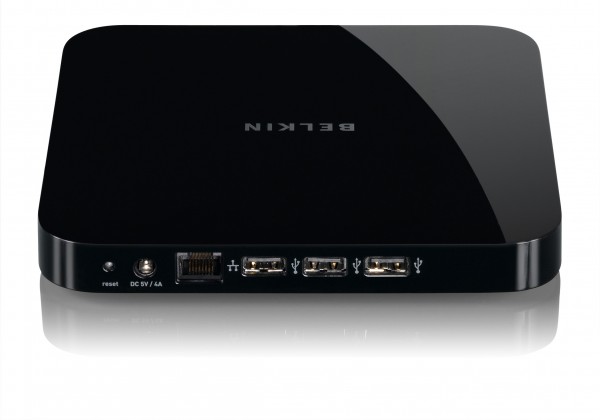
Individuals wishing to share content contained in a USB device such as a printer or drive over a network would need to have the means to connect via Ethernet or Wi-Fi. To address this need, there is Network USB Hub from Belkin, which allows sharing between the different peripherals connected to it. While the price may be a little on the steep side, at a cent shy of 130 dollars, this downside is easily overlooked depending on how effectively the individual puts the hub to use. Everyone will agree, though, that this is one gadget that works quite well and very user-friendly. A home-based network will benefit greatly from its functionality, as well as laptops for taking the content to wherever the user may go.
Network USB Hub is square-shaped and is shiny black in color, a design theme that matches the networking releases of Belkin like the NI Vision Draft-N router. While the hub itself is light, power is supplied to the unit via an external adapter. With every box an installation CD is included that contains a manual for using and maintaining the device, plus a cable for an Ethernet port. The shortness of this cable implies that the hub will have to be located near the router.
Armed with the guide, installing the device is foolproof. In a nutshell, the process can be described as turning on the hub and connecting it to a router via the Ethernet cable. For routers whose initial configurations do not provide DHCP, their users would have to change the settings accordingly. Thankfully, current routers mostly employ DHCP in their default settings.
The next order of business is to install another utility, the Control Center, to the host computer as well as other networked computers, if any. The software serves as the control surface for managing all the USB gadgets that are connected to the hub. It will show such information as connect status and device type of these items. Navigation among the controls is very fluid, with a nice layout to complement the sleek-looking hardware. The software drivers can run in both 32-bit and 64-bit Windows XP versions, Vista, and Mac OS X 10.3 and upwards.
Actually connecting a USB device is pretty much a no-brainer, and with the hub’s auto-detecting feature any USB product is easily determined and handled through the Control Center. However, hardware that requires drivers for it to run in the host computer will need to have these drivers pre-installed before the Control Center is able to connect to it. Three USB ports in the back plus the two in front means that the hub can manage five gadgets all at the same time. However, it is possible to connect several more via another hub to accommodate them, and the device will also handle these perfectly. All in all, the current version can support up to fifteen connections. Belkin, though, cautions against using devices with virtual private networks enabled and those that auto-detects its own connections. For these to work properly with the hub, the feature may have to be disabled while connected to the device.
The hub was further tested with various devices plugged in, from flash drives to digital cameras, to card readers and printers. All were detected and connected instantly. Windows OS recognized them like they were direct components connected to the computer, and even the hooked printer produced its usual output without delay, printing file content from another device connected to the device, an external hard drive. Gadgets whose power supplies are derived from a USB connection can hook up to the hub both for power and for data transfer. Users can even use the ports to recharge cellular phones and Bluetooth headsets. Disconnecting the devices is just as easy as connecting them. Simply unplug them from the Control Center or from the hub itself.
For home networks that cater to one user only, it is okay to have the devices auto-connect to the computer each and every time. However, networks with multiple computers accessing the hub will want turn this feature off since the hub is not really designed to be a server, which meant it cannot multitask several all at once. A device linked to the hub can be accessed by one computer only at any given time. In cases of a computer wishing to gain access to a gadget that is currently in use by another, the former would need to click on the Request Use button located in the Control Center. This will inform the other computer that the requester would like to use the device, and the latter need only click a corresponding button to answer. USB printers are enabled to work in auto-connect mode, and sever the connection as soon as the print work is complete. This makes it easier for multiple computers to gain access to the printer. A very nifty feature indeed, and overall the device is extremely useful. Probably the only nitpick that can be seen in the hub is its inability to let simultaneous multiple access to any gadget connected to it.
Though the hub is originally intended to be used in networks with PCs, it provides the same functionality with a laptop. Ideally, users may have one hub at the workplace and one at home, so that shuttling the laptop between the two locations will not result in awkward plugging and unplugging to connect to the various relevant devices in each location. The user simply connects to them wirelessly.
A few problems did manifest in the form of the hub being firewall-restricted by default, which meant that users will need to manually set the device in the firewall app as an allowed gadget to be connected. It was also observed that the Control Center jumps to a slow start when running in a computer that was just returned from sleep mode.
However, users can’t deny that finding a networking peripheral that truly does its intended use is a rarity. The Belkin Network USB Hub takes the cake by being one such device, with the added advantage of being easy to set up.










Comments